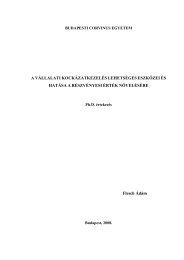THESES OF PH.D. DISSERTATION Barbara JENES
THESES OF PH.D. DISSERTATION Barbara JENES
THESES OF PH.D. DISSERTATION Barbara JENES
You also want an ePaper? Increase the reach of your titles
YUMPU automatically turns print PDFs into web optimized ePapers that Google loves.
The evaluation of country as a brand was measured and tested based on the model designed<br />
by Pappu and Quester (2010). Structural modeling was preceded by a confirmatory factor<br />
analysis during which the goodness of fit and significance of the measured variables and of<br />
their indicators was tested. The original model is a five-dimensional construct composed of<br />
country awareness, macro country image, micro country image, perceived quality and country<br />
loyalty (Pappu-Quester, 2010, p. 276.). To build their model the authors used and adapted<br />
well known scales that had already been tested and validated in previous studies. In our<br />
research the items of the scale has been developed according to the focus and specialities of<br />
the research model.<br />
According to the above, the variables used in the model are as follows:<br />
Country image within country equity models is described as “the total of all descriptive,<br />
inferential, and informational beliefs about a particular country”.(Martin – Eroglu, 1993, p.<br />
193.) Pappu and Quester (2010) in their model use the same approach.<br />
“Publications generally embrace [country image’s] multidimensional nature [...]. The<br />
cognitive, affective/evaluative, and conative phases of attitude formation are represented<br />
through the beliefs about a country and its products (cognitive), the feelings towards it and its<br />
products (affective), and behavioral intentions to purchase its products […] (conative)”<br />
(Nadeau et.al., 2008, p. 87.). Studies on country image found a direct relationship between<br />
country evaluation and the evaluation of its inhabitants several times. Therefore Nadeau et.al.<br />
(2008) in their study examine country character and people character as two separate entities.<br />
“[P]eople-beliefs may be best represented using two groups: character and competency<br />
beliefs” (Nadeau et.al., 2008, p. 88.)<br />
According to Pappu and Quester (2010, p. 278.), “country awareness, country associations,<br />
perceived quality and country loyalty are the four dimensions of country equity”. In our<br />
research the perceived quality item has been eliminated according to its product-level focus as<br />
the research model was developed on general level of attributes.<br />
Country awareness not only means that consumers are merely aware of a country, but their<br />
“ability to recognize or recall that the country is a producer of certain product category”<br />
(Pappu – Quester, 2010, p. 280.)<br />
In connection with country loyalty, Paswan et al. (2003) state that similarly to brand loyalty,<br />
one can formulate a loyalty towards countries. In their study, Pappu and Quester (2010, p.<br />
280.) based on the definition by Yoo and Donthu (2001, p. 3.) define country loyalty as “the<br />
tendency to be loyal to a focal country as demonstrated by the intention to buy products from<br />
the country as a primary choice”. In our research we transformed the item to a general<br />
meaning of country brand loyalty, instead of loyalty in connection with products. developed<br />
item in the scale, based on the original one by Pappu – Quester, 2010)<br />
According to Keller (1993), a relevant approach to country associations is the general view<br />
that consumers’ brand associations contribute to a brand’s equity. In their adaptation of this<br />
14

















